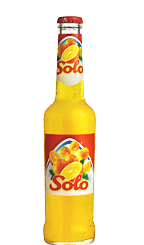Solo (Norwegian soft drink)
Solo is a popular Norwegian soft drink known for its distinctive orange flavor. First introduced in the 1930s, Solo quickly became a favorite among Norwegians and has since established itself as a classic beverage in Norway. Its history, unique taste, and cultural significance make it an interesting subject within the Norwegian beverage industry.
History[edit | edit source]
Solo was created in the early 1930s by Torleif Gulliksrud and Paul Lunde, who were inspired by the success of orange soft drinks in the United States. They aimed to create a similar product tailored for the Norwegian market. The drink was initially produced and bottled in the town of Tønsberg, Norway. The name "Solo" was chosen because it was easy to pronounce and remembered, signifying the drink's unique position in the market as a singular, standout product.
Ingredients and Flavor[edit | edit source]
The primary flavor of Solo is orange, derived from real orange concentrate. The drink's recipe has remained relatively unchanged since its inception, which is a testament to its timeless appeal. In addition to orange concentrate, Solo contains carbonated water, sugar, and citric acid, among other ingredients. The exact recipe is a closely guarded secret, contributing to Solo's unique taste and enduring popularity.
Varieties[edit | edit source]
Over the years, Solo has expanded its product line to include several variations catering to diverse consumer preferences. These include:
- Solo Super: A less sweet version with more carbonation.
- Solo Sunset: A variant with a taste of orange and exotic fruits.
- Solo Zero: A sugar-free version of the classic Solo, catering to those looking for a low-calorie option.
Cultural Significance[edit | edit source]
Solo is more than just a soft drink in Norway; it is a cultural icon. It has been a part of Norwegian outdoor life, celebrations, and everyday moments for decades. The brand has also been involved in various promotional activities, including limited edition bottles and nostalgic advertising campaigns that pay homage to its long history.
Packaging and Marketing[edit | edit source]
Solo's packaging has evolved over the years, from glass bottles to modern plastic bottles and cans, adapting to changing consumer preferences and environmental considerations. The brand's marketing strategies have effectively leveraged its heritage, emphasizing its status as a traditional Norwegian product while also appealing to younger generations.
See Also[edit | edit source]
Search WikiMD
Ad.Tired of being Overweight? Try W8MD's physician weight loss program.
Semaglutide (Ozempic / Wegovy and Tirzepatide (Mounjaro / Zepbound) available.
Advertise on WikiMD
|
WikiMD's Wellness Encyclopedia |
| Let Food Be Thy Medicine Medicine Thy Food - Hippocrates |
Translate this page: - East Asian
中文,
日本,
한국어,
South Asian
हिन्दी,
தமிழ்,
తెలుగు,
Urdu,
ಕನ್ನಡ,
Southeast Asian
Indonesian,
Vietnamese,
Thai,
မြန်မာဘာသာ,
বাংলা
European
español,
Deutsch,
français,
Greek,
português do Brasil,
polski,
română,
русский,
Nederlands,
norsk,
svenska,
suomi,
Italian
Middle Eastern & African
عربى,
Turkish,
Persian,
Hebrew,
Afrikaans,
isiZulu,
Kiswahili,
Other
Bulgarian,
Hungarian,
Czech,
Swedish,
മലയാളം,
मराठी,
ਪੰਜਾਬੀ,
ગુજરાતી,
Portuguese,
Ukrainian
Medical Disclaimer: WikiMD is not a substitute for professional medical advice. The information on WikiMD is provided as an information resource only, may be incorrect, outdated or misleading, and is not to be used or relied on for any diagnostic or treatment purposes. Please consult your health care provider before making any healthcare decisions or for guidance about a specific medical condition. WikiMD expressly disclaims responsibility, and shall have no liability, for any damages, loss, injury, or liability whatsoever suffered as a result of your reliance on the information contained in this site. By visiting this site you agree to the foregoing terms and conditions, which may from time to time be changed or supplemented by WikiMD. If you do not agree to the foregoing terms and conditions, you should not enter or use this site. See full disclaimer.
Credits:Most images are courtesy of Wikimedia commons, and templates Wikipedia, licensed under CC BY SA or similar.
Contributors: Prab R. Tumpati, MD

